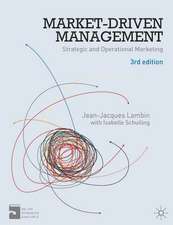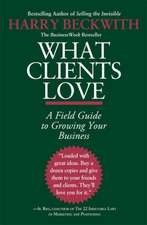Analytical CRM: Developing and Maintaining Profitable Customer Relationships in Non-Contractual Settings: Applied Marketing Science / Angewandte Marketingforschung
Autor Markus Wübben Cuvânt înainte de Prof. Dr. Florian von Wangenheimen Limba Engleză Paperback – 9 oct 2008
Din seria Applied Marketing Science / Angewandte Marketingforschung
- 13%
 Preț: 373.65 lei
Preț: 373.65 lei - 13%
 Preț: 372.71 lei
Preț: 372.71 lei -
 Preț: 380.45 lei
Preț: 380.45 lei -
 Preț: 393.35 lei
Preț: 393.35 lei -
 Preț: 481.20 lei
Preț: 481.20 lei - 13%
 Preț: 379.05 lei
Preț: 379.05 lei - 15%
 Preț: 439.05 lei
Preț: 439.05 lei - 15%
 Preț: 537.79 lei
Preț: 537.79 lei -
 Preț: 449.74 lei
Preț: 449.74 lei -
 Preț: 450.88 lei
Preț: 450.88 lei -
 Preț: 381.98 lei
Preț: 381.98 lei -
 Preț: 385.62 lei
Preț: 385.62 lei -
 Preț: 387.38 lei
Preț: 387.38 lei - 15%
 Preț: 439.38 lei
Preț: 439.38 lei -
 Preț: 451.26 lei
Preț: 451.26 lei -
 Preț: 487.96 lei
Preț: 487.96 lei -
 Preț: 451.48 lei
Preț: 451.48 lei -
 Preț: 483.12 lei
Preț: 483.12 lei -
 Preț: 483.70 lei
Preț: 483.70 lei -
 Preț: 382.36 lei
Preț: 382.36 lei -
 Preț: 424.61 lei
Preț: 424.61 lei -
 Preț: 351.88 lei
Preț: 351.88 lei -
 Preț: 380.84 lei
Preț: 380.84 lei - 15%
 Preț: 443.46 lei
Preț: 443.46 lei -
 Preț: 454.37 lei
Preț: 454.37 lei -
 Preț: 449.90 lei
Preț: 449.90 lei -
 Preț: 414.80 lei
Preț: 414.80 lei -
 Preț: 486.21 lei
Preț: 486.21 lei -
 Preț: 449.15 lei
Preț: 449.15 lei - 15%
 Preț: 480.05 lei
Preț: 480.05 lei -
 Preț: 412.68 lei
Preț: 412.68 lei -
 Preț: 384.09 lei
Preț: 384.09 lei -
 Preț: 451.87 lei
Preț: 451.87 lei -
 Preț: 479.08 lei
Preț: 479.08 lei - 15%
 Preț: 434.65 lei
Preț: 434.65 lei - 15%
 Preț: 436.60 lei
Preț: 436.60 lei -
 Preț: 412.13 lei
Preț: 412.13 lei - 25%
 Preț: 278.31 lei
Preț: 278.31 lei
Preț: 385.47 lei
Nou
Puncte Express: 578
Preț estimativ în valută:
73.77€ • 76.55$ • 61.66£
73.77€ • 76.55$ • 61.66£
Carte tipărită la comandă
Livrare economică 15-29 martie
Preluare comenzi: 021 569.72.76
Specificații
ISBN-13: 9783834912787
ISBN-10: 3834912786
Pagini: 263
Ilustrații: XXXI, 263 p.
Dimensiuni: 148 x 210 x 20 mm
Greutate: 0.35 kg
Ediția:2009
Editura: Gabler Verlag
Colecția Gabler Verlag
Seria Applied Marketing Science / Angewandte Marketingforschung
Locul publicării:Wiesbaden, Germany
ISBN-10: 3834912786
Pagini: 263
Ilustrații: XXXI, 263 p.
Dimensiuni: 148 x 210 x 20 mm
Greutate: 0.35 kg
Ediția:2009
Editura: Gabler Verlag
Colecția Gabler Verlag
Seria Applied Marketing Science / Angewandte Marketingforschung
Locul publicării:Wiesbaden, Germany
Public țintă
ResearchCuprins
Fundamentals of Customer Relationship Management.- The Drivers of Cross-Buying Behavior in Non-Contractual Settings.- Stochastic Models for Predicting Customer Activity and Future Best Customers in Non-Contractual Settings.- Support Vector Machines for Predicting Customer Activity and Future Best Customers in Non-Contractual Settings.- Reflections on Developing and Maintaining Customer Relationships in Non-Contractual Settings.- Customer Relationship Management in the 21st Century.
Notă biografică
Dr. Markus Wübben ist wissenschaftlicher Mitarbeiter bei Prof. Dr. Florian von Wangenheim am Lehrstuhl für Dienstleistungs- und Technologiemarketing der Technischen Universität München.
Textul de pe ultima copertă
The ever-increasing amount of individual-level customer data generated by loyalty programs opens new perspectives for customer relationship management (CRM). Yet, recent analyses have shown that a huge fraction of CRM projects fail to deliver the good at the bottom line. One of the main reasons for this dilemma is that these data require advanced analytical processing to fully leverage their potential (“analytical CRM”). Research and practice are still in its early stages with respect to analytical CRM.
Markus Wübben focuses on analytical CRM for developing and maintaining buyer-seller relationships in non-contractual settings, i.e. settings, in which buyer-seller relationships are not governed by a contract that predetermines the monetary value and/or length of the relationship. This is a common scenario for many businesses such as retailers, hotels, and airlines. Using empirical analyses on the basis of sound theoretical foundations, the author shows how customer relationships can be broadened, meaning how customers’ cross-buying behavior can be stimulated and how customers’ relationship length and depth, i.e. customers’ activity and purchase-levels, can be predicted. Finally, he derives implications for research and practice.
Markus Wübben focuses on analytical CRM for developing and maintaining buyer-seller relationships in non-contractual settings, i.e. settings, in which buyer-seller relationships are not governed by a contract that predetermines the monetary value and/or length of the relationship. This is a common scenario for many businesses such as retailers, hotels, and airlines. Using empirical analyses on the basis of sound theoretical foundations, the author shows how customer relationships can be broadened, meaning how customers’ cross-buying behavior can be stimulated and how customers’ relationship length and depth, i.e. customers’ activity and purchase-levels, can be predicted. Finally, he derives implications for research and practice.







